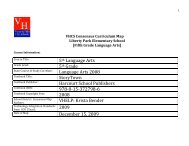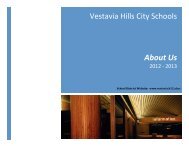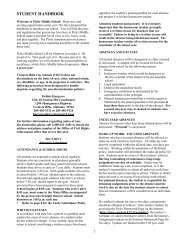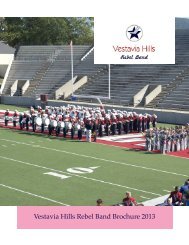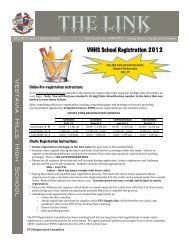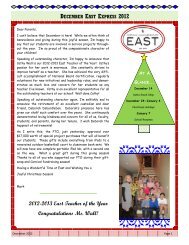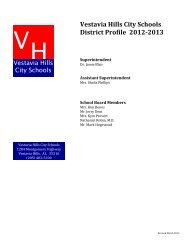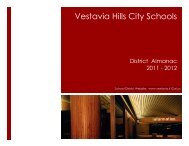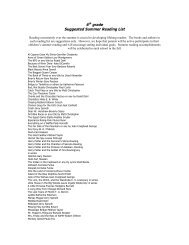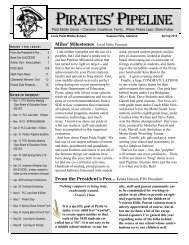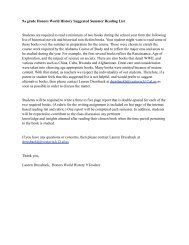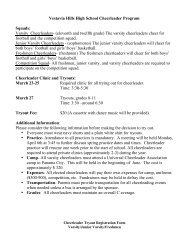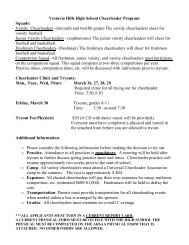AP Physics B Topics and Time Line Objectives Lab Activities With ...
AP Physics B Topics and Time Line Objectives Lab Activities With ...
AP Physics B Topics and Time Line Objectives Lab Activities With ...
Create successful ePaper yourself
Turn your PDF publications into a flip-book with our unique Google optimized e-Paper software.
<strong>AP</strong> <strong>Physics</strong> B<br />
Course Overview<br />
Class meets 1.5 periods or 90 minutes every day for 180 days. Students are encouraged to<br />
bring a lunch from home on lab days so they can gain an additional 25 minutes in the lab. The school<br />
year runs from early August until May. There is little time in class after the <strong>AP</strong> exams.<br />
The textbook is <strong>Physics</strong>: Principles with Applications 6 th edition, 2005 by Giancoli.<br />
Additional sources are Schaum’s Outline in <strong>Physics</strong> <strong>and</strong> Applied <strong>Physics</strong> as well as the exam prep<br />
book 5 Steps to a 5 for <strong>AP</strong> <strong>Physics</strong>.<br />
Experimental design, data analysis, <strong>and</strong> oral presentations of experiments are emphasized.<br />
Students are encouraged to individualize experiments they design. This sometimes leads to dart guns<br />
<strong>and</strong> matchbox cars on the same table as photogates <strong>and</strong> motion detectors! Students are required to keep<br />
a lab notebook <strong>and</strong> most labs require a written report that includes the hypothesis, apparatus diagram,<br />
procedure, observations presented in charts, <strong>and</strong> the written analysis of data with graphs.<br />
Open-ended <strong>Lab</strong>s begin with observing a phenomena <strong>and</strong> asking students what variables influence<br />
what we are observing. Students then design <strong>and</strong> conduct investigations to explore the relationships<br />
between the variables using equipment available in the lab. Students present graphs in class before<br />
writing lab reports at home.<br />
<strong>Topics</strong> <strong>and</strong><br />
<strong>Time</strong> <strong>Line</strong><br />
1 week<br />
Some of the review<br />
material is assigned<br />
over the summer<br />
<strong>and</strong> is due the first<br />
day of class in<br />
August.<br />
Kinematics in<br />
One<br />
Dimension<br />
1.5 weeks<br />
<strong>Objectives</strong> Resources <strong>Lab</strong> <strong>Activities</strong><br />
<strong>With</strong> Student <strong>Objectives</strong><br />
<strong>Physics</strong><br />
6 th edition<br />
Giancoli<br />
Chapter 1<br />
1. Skill review<br />
a. Metric system<br />
b. Data collection <strong>and</strong><br />
representation<br />
c. Graphing technique<br />
d. Precision vs. Accuracy<br />
e. Math modeling<br />
f. Experimental Design<br />
g. Use of the LoggerPro<br />
software Program <strong>and</strong><br />
Sensors<br />
Every student gets a copy of Logger<br />
Pro software by Vernier<br />
• Distinguish between displacement<br />
<strong>and</strong> distance <strong>and</strong> speed <strong>and</strong> velocity.<br />
• Relate average speed to distance<br />
traveled <strong>and</strong> time elapsed to solve<br />
problems involving such parameters.<br />
• Define acceleration <strong>and</strong> suggest<br />
means for measuring it.<br />
• Distinguish between average<br />
acceleration <strong>and</strong> instantaneous<br />
acceleration.<br />
• Write three general kinematics<br />
equations that involve the parameters<br />
distance, initial velocity, final velocity,<br />
acceleration, <strong>and</strong> time.<br />
• Use the kinematics equations to<br />
solve motion at constant acceleration<br />
problems.<br />
• Write the value of the acceleration<br />
due to gravity in both SI <strong>and</strong> English<br />
units.<br />
Modeling<br />
<strong>Physics</strong><br />
materials<br />
from<br />
Arizona<br />
State Univ.<br />
Giancoli<br />
<strong>Physics</strong><br />
6 th edition<br />
Chapter 2<br />
Modeling<br />
<strong>Physics</strong><br />
(ASU)<br />
Logger Pro<br />
Software,<br />
<strong>Lab</strong> Pro<br />
Interface <strong>and</strong><br />
probes,<br />
Dell Laptops<br />
Comparative Precision<br />
• Using a micrometer, vernier<br />
caliper, <strong>and</strong> metric rule<br />
determine the volume of<br />
various objects.<br />
• Discuss significant figures <strong>and</strong><br />
percent error<br />
Inertial Mass Open-ended<br />
• Use an inertial balance to<br />
determine the mathematical<br />
relationship between mass <strong>and</strong><br />
period<br />
• Determine math<br />
relationship/equation from<br />
graph of the variables.<br />
Dune Buggy – Open-ended<br />
• Analyze the motion of objects<br />
moving at constant speed<br />
• Use physics data to construct<br />
graphs.<br />
• Find the slope of a graph.<br />
• Construct displacement <strong>and</strong><br />
time graphs from<br />
experimental data.<br />
• Construct velocity <strong>and</strong> time<br />
graphs from experimental<br />
data.<br />
• Interpret graphs relating<br />
displacement vs. time.<br />
• Interpret graphs relating<br />
velocity vs. time.
Kinematics in<br />
Two<br />
Dimensions<br />
1.5 weeks<br />
Vectors<br />
1 Week<br />
• Describe the behavior of an object<br />
in free fall when neglecting air<br />
resistance.<br />
• Recognize that the equations of<br />
kinematics directly apply to bodies in<br />
free fall.<br />
• Use the quadratic equation to<br />
determine the time it takes a body<br />
projected vertically downward to reach<br />
the ground <strong>and</strong> explain the meaning of<br />
the extraneous solution.<br />
• Calculate the position <strong>and</strong> velocity<br />
at specific times for a body dropped<br />
from rest, or projected vertically<br />
downward, or projected vertically<br />
upwards with some initial velocity.<br />
• Distinguish between one <strong>and</strong> twodimensional<br />
motion.<br />
• Discuss the trajectory of a projectile<br />
in the earth's gravitational field.<br />
• Illustrate graphically how the<br />
motion of a horizontally projected<br />
baseball compares with that of a<br />
baseball dropped from rest.<br />
• Illustrate with diagrams how the<br />
vertical motion of a baseball thrown at<br />
any angle is similar to the motion of a<br />
baseball thrown vertically.<br />
• Predict the position <strong>and</strong> velocity of<br />
a projectile as a function of time when<br />
the projection angle <strong>and</strong> initial speed are<br />
given.<br />
• Predict the range, maximum<br />
altitude, <strong>and</strong> time of flight for a given<br />
projectile when the initial speed <strong>and</strong> the<br />
angle of projection are given.<br />
• Illustrate an underst<strong>and</strong>ing of<br />
relative motion in one <strong>and</strong> two<br />
dimensions. .<br />
• Measure <strong>and</strong> compare the horizontal<br />
<strong>and</strong> vertical displacements of a<br />
projectile.<br />
• To show that the trajectory of a<br />
projectile is parabolic.<br />
• Locate points, express angles,<br />
express rotation sense, <strong>and</strong> express<br />
distances in a Frame of Reference—the<br />
Cartesian coordinate system.<br />
• Define scalar <strong>and</strong> vector quantites<br />
<strong>and</strong> site examples.<br />
• Define vector sum <strong>and</strong> resultant of<br />
two or more vectors.<br />
• Use the Tip-to-Tail Method to find<br />
the resultant of two vectors.<br />
• Determine the x <strong>and</strong> y-components<br />
of a given vector by graphical methods<br />
<strong>Physics</strong> with<br />
Computers<br />
Volz, Sapatka<br />
Vernier Pub.<br />
Giancoli<br />
Chap 3<br />
Modeling<br />
<strong>Physics</strong><br />
(ASU)<br />
Alabama<br />
Science in<br />
Motion<br />
PASCO <strong>Lab</strong><br />
equipment <strong>and</strong><br />
software<br />
provider<br />
Giancoli<br />
Chap 3<br />
Schaum’s<br />
Outline<br />
Series<br />
College<br />
<strong>Physics</strong><br />
8 th edition<br />
Picket Fence Open-Ended<br />
• Determine the acceleration due to<br />
gravity using an acrylic<br />
“picket fence”, photogate,<br />
Vernier <strong>Lab</strong> Pro, <strong>and</strong> Logger<br />
Pro software.<br />
• Analyze position-time, velocitytime<br />
<strong>and</strong> acceleration-time<br />
graphs<br />
• Determine the factors that<br />
introduce error in this activity<br />
Assignments:<br />
Selected items from Chapters 2 [#<br />
7-11, 16, 18, 20, 21, 23, 24, 27, 28,<br />
38-42, 47, 52, 53, 56]<br />
Range Vs Angle Open-Ended<br />
• Describe the motion of a<br />
projectile in two-dimensional<br />
space.<br />
• Measure <strong>and</strong> compare the<br />
horizontal <strong>and</strong> vertical<br />
displacements of a projectile.<br />
• Predict <strong>and</strong> verify<br />
experimentally the range of a<br />
projectile.<br />
Video Analysis of the path of a<br />
Basketball<br />
<strong>Objectives</strong>:<br />
Produce position-time, velocitytime,<br />
<strong>and</strong> acceleration-time graphs<br />
for the vertical <strong>and</strong> horizontal<br />
motion of a basketball from a video<br />
Assignment:<br />
Chapter 3 [#21- 48 odd ]<br />
Force Tables<br />
• Calculate the force acting on a<br />
string from the sum of the<br />
masses<br />
• Calculate the resultant of the<br />
given force vectors graphically<br />
<strong>and</strong>/or using rectangular<br />
components<br />
• Experimentally verify results by<br />
balancing the vectors with their<br />
equilibrant<br />
2
Newton’s Laws<br />
a. Statics<br />
b. Dynamics<br />
c. Newton’s 3 rd<br />
Law<br />
d. <strong>Line</strong>ar<br />
Momentum<br />
e. Rotational<br />
Motion<br />
f. Static<br />
Equilibrium<br />
9 weeks<br />
• Calculate the magnitude <strong>and</strong> the<br />
direction of a vector when its<br />
rectangular components are given.<br />
• Calculate the resultant of two or<br />
more vectors using the Component<br />
Method.<br />
• Demonstrate by definition <strong>and</strong><br />
example an underst<strong>and</strong>ing of the<br />
distinction between mass <strong>and</strong> weight.<br />
• Define the units newton <strong>and</strong> slug <strong>and</strong><br />
be able to express them in SI <strong>and</strong><br />
English units.<br />
• Demonstrate an underst<strong>and</strong>ing of<br />
Newton's First Law of Motion.<br />
• State the 1 st Condition of Equilibrium<br />
• Draw free-body diagrams for a<br />
variety of static problems <strong>and</strong> solve<br />
for the unknown paramenters<br />
• Demonstrate an underst<strong>and</strong>ing of<br />
Newton's Second Law of Motion.<br />
• Draw a free-body diagram for a body<br />
or a system of bodies in motion with<br />
a constant acceleration, set the<br />
resultant force equal to the total mass<br />
times the acceleration, <strong>and</strong> solve for<br />
the unknown parameters.<br />
• Relate Newton's First <strong>and</strong> Second<br />
Laws to kinematics.<br />
• State specific examples to illustrate<br />
an underst<strong>and</strong>ing of Newton's Third<br />
Law of Motion.<br />
• Analyze the motion of an accelerating<br />
elevator.<br />
• Determine the velocity change of a<br />
body that results when a constant<br />
force is applied over a given period of<br />
time.<br />
• Discuss the forces of kinetic <strong>and</strong><br />
static friction <strong>and</strong> suggest a means of<br />
measuring them.<br />
• Analyze the motion of a body<br />
accelerating on an inclined plane with<br />
friction.<br />
• Distinguish between the linear <strong>and</strong><br />
angular values for velocity,<br />
displacement, <strong>and</strong> acceleration.<br />
• Write the angular <strong>and</strong> linear versions<br />
of the 7 kinematic equations.<br />
• Explain the 2 components of angular<br />
acceleration (centripetal <strong>and</strong><br />
tangential).<br />
• Define center of mass <strong>and</strong> calculate<br />
for given objects.<br />
• Relate Torque <strong>and</strong> F=ma<br />
<strong>Physics</strong><br />
Giancoli<br />
Chap 4<br />
Chap 5<br />
Chap 7<br />
Logger Pro<br />
sosftware, <strong>Lab</strong><br />
Pro interface<br />
<strong>and</strong> probes,<br />
Dell computers<br />
Chapter 8<br />
Chapter 9<br />
Guess <strong>and</strong> Build Open-Ended<br />
• Guess the reading on spring<br />
scales in various arrangements<br />
with pulleys <strong>and</strong> weights, then<br />
build the setup <strong>and</strong> read the<br />
spring scales.<br />
• Explain reasoning for<br />
predictions when pre <strong>and</strong> post<br />
lab answers don’t match.<br />
Center of Gravity<br />
• Determine the center of<br />
gravity of various geometric<br />
shapes using the plumb-line<br />
method.<br />
Hallway Hockey Open-Ended<br />
• Observe the interaction<br />
between air hockey pucks <strong>and</strong><br />
outside contact forces<br />
• Explain the relationship<br />
between Newton’s 1 st Law <strong>and</strong><br />
the behavior<br />
F = ma<br />
Open-Ended<br />
• Experimentally determine the<br />
relationship between force,<br />
mass, <strong>and</strong> acceleration using<br />
dynamic carts, tracks, <strong>and</strong><br />
motion sensors.<br />
• Graphically derive the<br />
relationship between the<br />
variables<br />
Coefficient of Friction<br />
Open-Ended<br />
• Determine the coefficient of<br />
static friction between two<br />
surface<br />
• Demonstrate that the frictional<br />
force is independent of area<br />
• Student designed lab using<br />
Vernier force probes, <strong>Lab</strong> Pro<br />
interfaces <strong>and</strong> computers<br />
Conservation of<br />
Momentum Student<br />
Designed <strong>Lab</strong><br />
• Design <strong>and</strong> conduct an<br />
experiment to explore the law<br />
of Conservation of Momentum<br />
• Explain results of lab <strong>and</strong> lab<br />
design orally <strong>and</strong> in a written<br />
format.<br />
3
• Explain how the moment of inertia<br />
changes for a student on a spinning<br />
stool as they open <strong>and</strong> close their<br />
arms.<br />
• Calculate the rotational kinetic<br />
energy <strong>and</strong> apply conservation of<br />
energy to an object rolling down an<br />
incline plane.<br />
• Explain why the angular momentum<br />
of a rotating object depends upon the<br />
choice of axis.<br />
• Define precession <strong>and</strong> explain the<br />
behavior of gyroscopes.<br />
• Using a spinning bicycle wheel<br />
explain the right-h<strong>and</strong> rule.<br />
• Solve multi-step problems using the<br />
1 st <strong>and</strong> 2 nd conditions of equilibrium.<br />
Torque Mini-<strong>Lab</strong>s<br />
Open-Ended<br />
• In terms of torque, explain<br />
what you feel as a 200g mass<br />
is slid down a held meterstick.<br />
• Why does Conservation of<br />
angular momentum hold true<br />
for a student spinning on a<br />
stool holding h<strong>and</strong>-weights.<br />
• Predict which will reach the<br />
end of an incline first, a ring or<br />
disk. Explain in terms of<br />
inertia.<br />
Project – Build a perfectly<br />
balanced mobile to hang from the<br />
ceiling<br />
Universal<br />
Gravitation<br />
<strong>and</strong> Kepler’s<br />
Laws<br />
1.5 week<br />
• State the conditions that are<br />
necessary for uniform circular<br />
motion.<br />
• Underst<strong>and</strong> how acceleration is<br />
possible without a change in<br />
speed.<br />
• Show that all circular motion<br />
equations are dimensionally<br />
correct.<br />
• Apply underst<strong>and</strong>ings of<br />
centripetal force to examples of<br />
motion in a vertical circle.<br />
• Use Newton's Universal Law of<br />
Gravitation to derive the<br />
acceleration due to gravity for<br />
the surface of the earth <strong>and</strong> for<br />
the surfaces of other planets<br />
when the radii <strong>and</strong> the masses of<br />
the planets are given.<br />
• Use Newton's Universal Law <strong>and</strong><br />
Newton's Second Law of Motion<br />
to express weight for any<br />
location in the universe.<br />
• Determine mass from weight or<br />
weight from mass where a value<br />
for the acceleration due to<br />
gravity is known.<br />
Giancoli<br />
Chapter 5<br />
Modulus <strong>Lab</strong> – Student<br />
Designed<br />
• Students will design <strong>and</strong><br />
conduct an experiment<br />
exploring the relationships<br />
defined by one of the<br />
following: Young’s Modulus,<br />
Shear Modulus, or Bulk<br />
Modulus<br />
• Written <strong>and</strong> oral reports are<br />
required<br />
Centripetal Force on a<br />
Rubber Stopper Open-Ended<br />
• Experimentally determine the<br />
relationships between the<br />
factors that influence the<br />
motion of a rubber stopper on<br />
a length of string.<br />
• Students design <strong>and</strong> conduct<br />
the experiment<br />
• Derive equation from the<br />
graphs<br />
Equal Areas <strong>and</strong> Ellipse<br />
Activity Open-Ended<br />
• Using graph paper, push-pins,<br />
<strong>and</strong> string create 3<br />
different ellipses <strong>and</strong><br />
explain what you did to<br />
make them different.<br />
Assignments:<br />
Selected Items from Chapter 5<br />
[Problems 1-9 Odd, 10-13, 19, 28-<br />
32, 34, 43, 44, 53 & 54<br />
4
Work, Power,<br />
Conservation<br />
of Energy<br />
2 weeks<br />
• Determine the acceleration due<br />
to gravity for various positions<br />
on the surface <strong>and</strong> above the<br />
surface of the earth.<br />
• Apply centripetal force <strong>and</strong><br />
gravitation to satellite motion.<br />
• Explain <strong>and</strong> apply the<br />
relationship between the speed<br />
<strong>and</strong> the orbital radius of a<br />
satellite.<br />
• Demonstrate proficiency in<br />
solving problems involving<br />
apparent weightlessness in a<br />
satellite <strong>and</strong> in an elevator.<br />
• State Kepler's Three Laws of<br />
Planetary Motion.<br />
• Use Kepler's Third Law to relate<br />
the radius of an orbit to its<br />
period.<br />
• Relate energy changes in elastic <strong>and</strong><br />
completely inelastic collisions.<br />
• Underst<strong>and</strong> that momentum <strong>and</strong><br />
kinetic energy are conserved in<br />
elastic collisions.<br />
• Use energy <strong>and</strong> momentum<br />
principles to discuss what occurs<br />
after an elastic collision has<br />
stopped.<br />
• Define physical work.<br />
• State the conditions necessary for<br />
the performance of physical work.<br />
• Define the joule, the erg, <strong>and</strong> the<br />
foot pound as work or energy units.<br />
• Write a mathematical statement for<br />
calculating the work done by a<br />
given force <strong>and</strong> demonstrate that the<br />
equation is dimensionally correct.<br />
• Recognize that the area beneath a<br />
Force vs. Distance curve is work<br />
done over the distance interval.<br />
• Define kinetic energy.<br />
• Demonstrate by example <strong>and</strong> by<br />
experiment the relationship between<br />
the performance of work <strong>and</strong> the<br />
corresponding change in kinetic<br />
energy.<br />
• Calculate the kinetic energy of a<br />
body when it’s mass or weight is<br />
given.<br />
• Discuss the Work-Energy Theorem<br />
<strong>and</strong> express it as a mathematical<br />
statement.<br />
• Define potential energy.<br />
• Define gravitational potential<br />
energy.<br />
• Write an equation that will<br />
determine the gravitational potential<br />
<strong>Physics</strong><br />
Giancoli<br />
Chap 6-7<br />
<strong>Physics</strong><br />
with<br />
Computers<br />
Vernier Pub<br />
Dell Computers<br />
<strong>Lab</strong> Pro<br />
Logger Pro<br />
Hooke’s Law Open-Ended<br />
• Experimentally determine the<br />
spring constant of a spring by<br />
measuring the elongation of<br />
the spring for a given applied<br />
force.<br />
• Interpret <strong>and</strong> analyze a Force<br />
vs. Elongation experimental<br />
graph for a Hooke's Law<br />
experiment.<br />
• Determine the potential<br />
energy of a compressed or<br />
elongated spring.<br />
• Show that the change in<br />
gravitational potential energy<br />
of a mass-spring system is<br />
equal to the change in spring<br />
potential energy.<br />
Power Open-ended<br />
• Every student will determine<br />
his horsepower after walking<br />
<strong>and</strong> running up a stairwell.<br />
Conservation of Energy<br />
Student Designed<br />
• Students will design <strong>and</strong><br />
conduct an experiment to<br />
explore conservation of<br />
energy.<br />
• Present results orally <strong>and</strong> in a<br />
written format.<br />
Assignment:<br />
Odd problems 1-50<br />
5
energy of a known mass or weight<br />
relative to a given location in space.<br />
• State <strong>and</strong> write the Law of<br />
Conservation of Mechanical<br />
Energy. Include kinetic, spring<br />
potential, gravitational potential<br />
energies, <strong>and</strong> work due to friction.<br />
• State <strong>and</strong> give a mathematical<br />
equation for Hooke's Law.<br />
• Explain the meaning of the negative<br />
sign in the equation expressing<br />
Hooke's Law.<br />
• Discuss the meaning of the<br />
expression conservative force.<br />
• Underst<strong>and</strong> the significance of a<br />
conservative force.<br />
• Underst<strong>and</strong> that the gravitational<br />
field is a conservative field.<br />
• Underst<strong>and</strong> that the spring force is a<br />
conservative force.<br />
• Underst<strong>and</strong> the relationship between<br />
work, energy, <strong>and</strong> power.<br />
• Define <strong>and</strong> compare the units of the<br />
watt, kilowatt, <strong>and</strong> horsepower as<br />
they are used to measure power.<br />
• Demonstrate by example an<br />
underst<strong>and</strong>ing of the concept of<br />
power.<br />
Fluids<br />
1 week<br />
Laws of<br />
Thermodynamics<br />
1.5 weeks<br />
• Define the properties of fluids.<br />
• In terms of structure, distinguish the<br />
differences between solids, liquids,<br />
gases, <strong>and</strong> plasma.<br />
• Distinguish between mass density,<br />
weight density, <strong>and</strong> specific gravity.<br />
• Define the concept of pressure <strong>and</strong><br />
that of absolute pressure.<br />
• State <strong>and</strong> apply Pascal's Principle.<br />
• State Archimedes' Principle <strong>and</strong> its<br />
relationship to buoyancy.<br />
• Underst<strong>and</strong> Bernoulli's Equation<br />
<strong>and</strong> its application to ideal fluids.<br />
• Demonstrate an underst<strong>and</strong>ing of<br />
the workings of an airfoil.<br />
• Explain continuity principle <strong>and</strong><br />
relate to conservation of energy<br />
• Define a thermodynamic system.<br />
• Differentiate between state <strong>and</strong> phase.<br />
• Give two examples in which the<br />
internal energy of a system can be<br />
changed.<br />
• State the First Law of<br />
Thermodynamics, give two examples<br />
in which the law is demonstrated, <strong>and</strong><br />
represent the first law mathematically.<br />
• Define <strong>and</strong> give illustrated examples<br />
of each of the following<br />
Giancoli<br />
Chap 10<br />
Giancoli<br />
Chapters<br />
13-15<br />
Univ. of<br />
Michigan<br />
1101 <strong>Lab</strong><br />
Cartesian Diver Project<br />
Student designed<br />
Students will build a Cartesian<br />
diver from plastic pipets, hex nuts,<br />
<strong>and</strong> a soda bottle. They will also<br />
explain the principles behind their<br />
device.<br />
Conservation of Energy<br />
<strong>and</strong> Heat open-ended<br />
• Use conservation of energy<br />
to describe the behavior of<br />
a system when internal<br />
energy changes<br />
• Calculate the transfer of<br />
thermal energy<br />
6
Simple<br />
Harmonic<br />
Motion,<br />
Waves,<br />
<strong>and</strong><br />
Sound<br />
3 Weeks<br />
thermodynamic processes: (a)<br />
adiabatic, (b) isochoric, (c) isothermal,<br />
<strong>and</strong> (d) isobaric.<br />
• Explain the significance of a PV<br />
diagram in describing (a) adiabatic, (b)<br />
isochoric, (c) isothermal, <strong>and</strong> (d)<br />
isobaric thermodynamic processes.<br />
• State the Second Law of<br />
Thermodynamics.<br />
• Define the entropy of a system.<br />
• Explain the operation <strong>and</strong> the<br />
limitations of the efficiency of a heat<br />
engine.<br />
• Determine the efficiency of a heat<br />
engine in terms of heat input <strong>and</strong> heat<br />
output.<br />
• Determine the efficiency of a heat<br />
engine in terms of input temperature<br />
<strong>and</strong> output temperature.<br />
• Differentiate between Carnot<br />
Efficiency <strong>and</strong> actual efficiency as<br />
applied to heat engines.<br />
• Describe simple harmonic motion<br />
(SHM) through examples.<br />
• Define the parameters of SHM.<br />
• Describe the relationships between<br />
force <strong>and</strong> displacement in simple<br />
harmonic motion.<br />
• Describe <strong>and</strong> illustrate how the<br />
magnitude <strong>and</strong> direction of velocity<br />
varies as a function of time in SHM.<br />
• Describe <strong>and</strong> illustrate how the<br />
magnitude <strong>and</strong> direction of<br />
acceleration varies as a function of<br />
time in SHM.<br />
• Calculate the frequency or period<br />
when the position <strong>and</strong> acceleration<br />
of an object at any instant during<br />
SHM are given.<br />
• Determine the period <strong>and</strong> total<br />
energy of a simple pendulum<br />
undergoing SHM.<br />
• Use the reference circle to describe<br />
the displacement, velocity <strong>and</strong><br />
acceleration.<br />
• Describe <strong>and</strong> apply Hooke’s law<br />
<strong>and</strong> Newton’s second law to<br />
determine the acceleration as a<br />
function of displacement.<br />
• Describe <strong>and</strong> illustrate transverse<br />
<strong>and</strong> longitudinal wave motion.<br />
• Describe, relate, <strong>and</strong> illustrate the<br />
meaning of frequency, speed, <strong>and</strong><br />
wavelength as they apply to wave<br />
motion.<br />
• Underst<strong>and</strong> the principles of<br />
reflection, refraction, dispersion,<br />
Giancoli<br />
Chapters<br />
11-12<br />
Vernier’s<br />
<strong>Physics</strong> with<br />
Computers<br />
<strong>Physics</strong><br />
Demos in<br />
Sound <strong>and</strong><br />
Waves<br />
Video series<br />
Pendulum <strong>Lab</strong> Open-Ended<br />
• Experimentally determine the<br />
relationship between the<br />
period of a pendulum <strong>and</strong><br />
the mass of the bob .<br />
• Experimentally determine the<br />
relationship between the<br />
period of a pendulum <strong>and</strong><br />
the length of the cord.<br />
Optional <strong>Lab</strong>s (if time allows)<br />
*Mass on a spring with<br />
Computer<br />
*Energy Conservation <strong>and</strong><br />
SHM with computer<br />
Speed of Sound Open-ended<br />
• Compare the calculated<br />
speed of sound<br />
determined from<br />
classroom temperature to<br />
the experimental speed of<br />
sound determined with a<br />
cardboard tube, tuning<br />
fork, <strong>and</strong> pitcher of water.<br />
7
Electrostatics<br />
Current <strong>and</strong><br />
Circuits<br />
3 weeks<br />
<strong>and</strong> diffraction as they relate to<br />
mechanical waves.<br />
• Underst<strong>and</strong> the mathematics of<br />
traveling <strong>and</strong> st<strong>and</strong>ing waves.<br />
• Distinguish between the<br />
physiological <strong>and</strong> physical<br />
definitions of sound.<br />
• State ways of approximating the<br />
speed of sound in liquids <strong>and</strong> gases<br />
knowing the speed of sound in air.<br />
• Distinguish between harmonics <strong>and</strong><br />
overtones as they apply to a<br />
vibrating system with fixed end<br />
points.<br />
• Define resonance.<br />
• Discuss the origin <strong>and</strong> significance<br />
of beats.<br />
• Use the superposition principle <strong>and</strong><br />
determine the resultant wave when<br />
two waves merge.<br />
• Use the Doppler effect to predict the<br />
apparent change in sound frequency<br />
that occurs as a result of relative<br />
motion between a source <strong>and</strong> an<br />
observer.<br />
• Discuss the nature of electrical charge.<br />
• Underst<strong>and</strong> charge quantization.<br />
• Recognize that all charges are multiple<br />
of the fundamental unit of charge, e.<br />
• Demonstrate that charge is conserved.<br />
• Explain how to charge a body by<br />
induction.<br />
• Distinguish between an insulator <strong>and</strong> a<br />
conductor.<br />
• Write Coulomb's Law <strong>and</strong> express it in<br />
terms of an equation.<br />
• Apply Coulomb's Law to problems<br />
involving systems of point charges.<br />
• Define the electrical field in terms of an<br />
isolated point charge.<br />
• Show how the electric field is similar to<br />
a gravitational field.<br />
• Calculate the magnitude <strong>and</strong> the<br />
direction of the force that would act on<br />
a test charge placed at a given point in<br />
an electric field.<br />
• Write a mathematical expression to<br />
determine the electrical field at a given<br />
point in space.<br />
• Calculate the electric field of a system<br />
of charge distributions.<br />
• Discuss the motion of a charged particle<br />
in a uniform electric field.<br />
• Distinguish by definition <strong>and</strong> example<br />
between potential energy, electric<br />
potential, <strong>and</strong> electric potential<br />
8<br />
<strong>Physics</strong><br />
6 th Edition<br />
Chapters<br />
16-18<br />
Computer<br />
Software<br />
St<strong>and</strong>ing Waves on a String<br />
Open-ended<br />
• Explain how st<strong>and</strong>ing waves<br />
are formed<br />
• Determine the speed <strong>and</strong><br />
frequency of a st<strong>and</strong>ing wave<br />
on a string.<br />
• Tell what determines the<br />
natural frequency of a<br />
vibrating system.<br />
Static Electricity <strong>Lab</strong><br />
Open-Ended<br />
• Students will make qualitative<br />
observations of the behavior of<br />
an electroscope when it is<br />
charged by conduction <strong>and</strong> by<br />
induction.<br />
Electrostatics 3D<br />
Computer simulation
difference.<br />
• Distinguish between positive <strong>and</strong><br />
negative work.<br />
• Compute the potential energy of a<br />
known charge at a given distance from<br />
another known charge <strong>and</strong> state<br />
whether the potential energy is<br />
positive or negative.<br />
• Determine the electric potential at any<br />
point due to a charge of known<br />
magnitude.<br />
• Calculate the electric potential at a point<br />
in the neighborhood of a number of<br />
isolated charges.<br />
• Find the force that would be exerted on<br />
a given charge placed between two<br />
oppositely charged parallel plates of<br />
known separation <strong>and</strong> potential<br />
difference.<br />
• Define the electron volt, eV, <strong>and</strong> be able<br />
to express energy in terms of this unit.<br />
• Define the dielectric strength of a<br />
material <strong>and</strong> describe the part it plays<br />
in limiting the charge that can be<br />
placed on a conductor.<br />
• Discuss the effects of the size <strong>and</strong> the<br />
shape of a conductor on its ability to<br />
store a charge.<br />
• Derive a relationship between applied<br />
voltage, capacitance, <strong>and</strong> total charge.<br />
• Calculate the capacitance of a parallelplate<br />
capacitor when the area of the<br />
plates is given <strong>and</strong> they are separated<br />
by a medium of a known dielectric<br />
constant.<br />
• Define permittivity <strong>and</strong> give examples<br />
illustrating its effect on a capacitor.<br />
• Define <strong>and</strong> calculate the energy of a<br />
charged capacitor.<br />
• Define the ampere as the unit of<br />
Eelectrical current.<br />
• Distinguish between conventional flow<br />
<strong>and</strong> electron flow.<br />
• State Ohm's Law for electrical<br />
components.<br />
• Define the unit of resistance, the ohm.<br />
• Determine the potential drop across a<br />
resistance carrying a given current.<br />
• Define the factors that determine the<br />
resistance of a given wire.<br />
• Calculate the resistance of a wire given<br />
its resistivity, length, <strong>and</strong> radius.<br />
• Explain, on the atomic level, the effect<br />
of increased temperature in a given<br />
resistance.<br />
• Calculate the change in resistance of a<br />
conductor with change in temperature.<br />
<strong>Physics</strong><br />
with<br />
Computers<br />
<strong>Physics</strong><br />
with<br />
Computers<br />
The Magnetic Field in a<br />
Slinky<br />
• Determine the relationship<br />
between magnetic field<br />
<strong>and</strong> the current in a<br />
solenoid<br />
• Determine the relationship<br />
between the magnetic<br />
field <strong>and</strong> the number of<br />
turns per meter in a<br />
solenoid.<br />
• Determine the value of the<br />
permeability constant µ o<br />
Ohm’s Law<br />
• Determine the mathematical<br />
relationship between<br />
current, potential<br />
difference, <strong>and</strong> resistance<br />
in a simple circuit.<br />
• Compare the potential vs.<br />
current behavior of a<br />
resistor to that of a light<br />
bulb.<br />
9
Light <strong>and</strong><br />
Optics<br />
3 Weeks<br />
• Relate the potential difference across a<br />
resistor carrying a current to its energy<br />
loss.<br />
• Define the watt as the unit of electrical<br />
power.<br />
• Determine the power loss across a<br />
given current carrying resistance.<br />
• Write <strong>and</strong> apply Kirchhoff's Rules for<br />
electrical networks in the<br />
determination of unknown currents.<br />
• Analyze multiloop circuits using<br />
Ohm's Law <strong>and</strong> Kirchhoff's Rules.<br />
• Calculate the equivalent capacitance of<br />
a number of capacitors arranged in (1)<br />
series, (2) parallel, <strong>and</strong> (3) series <strong>and</strong><br />
parallel combination.<br />
• Explain how electromagnetic waves<br />
are produced.<br />
• Describe the electromagnetic spectrum<br />
<strong>and</strong> the relationship between<br />
frequency, wavelength, <strong>and</strong> speed of<br />
electromagnetic waves.<br />
• Describe the Roemer <strong>and</strong> Michelson<br />
experiment to determine the speed of<br />
light.<br />
• Explain the dispersion of light <strong>and</strong> the<br />
visible spectrum.<br />
• Use Huygen's Principle to explain<br />
diffraction <strong>and</strong> refraction.<br />
• Explain how the phenomena of<br />
diffraction <strong>and</strong> interference<br />
demonstrate the wave nature of light.<br />
• Give graphic examples of constructive<br />
<strong>and</strong> destructive interference.<br />
• Discuss single-slit diffraction.<br />
• Explain how diffraction gratings are<br />
used in spectroscopy.<br />
• Describe how thin films produce<br />
colorful displays.<br />
• Underst<strong>and</strong> the interference patterns<br />
produced by light reflecting off the<br />
two surfaces of a thin film.<br />
• Underst<strong>and</strong> how anti-reflective<br />
coatings work.<br />
• Apply the diffraction-grating equation<br />
to solve problems involving diffraction<br />
gratings.<br />
• Describe the phenomenon of<br />
polarization.<br />
• Explain the dispersion of light <strong>and</strong><br />
the visible spectrum.<br />
• Use Huygen's Principle to explain<br />
diffraction <strong>and</strong> refraction.<br />
• Discuss Young's experiment <strong>and</strong> its<br />
significance.<br />
• Explain how the phenomena of<br />
diffraction <strong>and</strong> interference<br />
Univ. of<br />
Michigan<br />
1101 <strong>Lab</strong><br />
Alabama<br />
Science<br />
In Motion<br />
Electrical Energy <strong>and</strong> Heat<br />
• Open ended<br />
• Measure the rate at which a<br />
light bulb transfers energy<br />
to an aquarium.<br />
Young’s Double Slit Experiment<br />
• To determine the wavelength<br />
of a source of light by using a<br />
double-slit <strong>and</strong> a diffraction<br />
grating of known spacing.<br />
Teacher demo-lab<br />
<strong>Time</strong> allotted: 30 minutes<br />
Assignments:<br />
Selected items from Chapters 22<br />
<strong>and</strong> 24<br />
<strong>AP</strong> Problem Set # 10: [1996 #3,<br />
1999 #6B, 2000 #B4, <strong>and</strong> 2004 #<br />
4]<br />
Plane Mirror <strong>Lab</strong><br />
Open ended<br />
• Investigate the positions<br />
<strong>and</strong> characteristics of<br />
images produced by plane<br />
<strong>and</strong> curved mirrors.<br />
10
demonstrate the wave nature of light.<br />
• Give graphic examples of<br />
constructive <strong>and</strong> destructive<br />
interference.<br />
• Discuss single-slit diffraction.<br />
• Explain how diffraction gratings are<br />
used in spectroscopy.<br />
• Describe how thin films produce<br />
colorful displays.<br />
• Underst<strong>and</strong> the interference patterns<br />
produced by light reflecting off the<br />
two surfaces of a thin film.<br />
• Underst<strong>and</strong> how anti-reflective<br />
coatings work.<br />
• Apply the diffraction-grating<br />
equation to solve problems involving<br />
diffraction gratings.<br />
• Describe the phenomenon of<br />
polarization.<br />
• Describe the characteristics of plane<br />
mirrors.<br />
• Demonstrate an underst<strong>and</strong>ing of the<br />
nature of the images formed by plane<br />
mirrors.<br />
• Distinguish between virtual <strong>and</strong> real<br />
images.<br />
• Define magnification in terms of<br />
image height <strong>and</strong> object height.<br />
• Distinguish between plane mirrors<br />
<strong>and</strong> spherical mirrors.<br />
• Underst<strong>and</strong> the characteristics of<br />
converging <strong>and</strong> diverging mirrors.<br />
• Describe the images formed by<br />
converging <strong>and</strong> diverging mirrors.<br />
• Use ray-tracing techniques to<br />
construct images formed by spherical<br />
mirrors.<br />
• Define the focal length of a spherical<br />
mirror.<br />
• Use the spherical mirror equation to<br />
solve problems.<br />
• Calculate the magnification of a<br />
spherical mirror.<br />
• Define index of refraction.<br />
• Underst<strong>and</strong> the relationships between<br />
index of refraction, Snell's law, <strong>and</strong><br />
critical angle.<br />
• Distinguish between converging <strong>and</strong><br />
diverging lenses.<br />
• Underst<strong>and</strong> the characteristics of<br />
converging <strong>and</strong> diverging lenses.<br />
• Describe the images formed by<br />
converging <strong>and</strong> diverging lenses.<br />
• Use ray-tracing techniques to<br />
construct images formed by lenses.<br />
• Define the focal length of a lens.<br />
• Use the thin lens equation to solve<br />
Index of Refraction<br />
• Explain Snell’s law <strong>and</strong> its<br />
application to transparent<br />
materials.<br />
• Explain what the index of<br />
refraction tells you about a<br />
transparent material <strong>and</strong> how<br />
it can be measured<br />
experimentally.<br />
• Determine the index of<br />
refraction of crown <strong>and</strong> flint<br />
glass.<br />
Lenses – Open Ended<br />
• Observe the positions <strong>and</strong><br />
characteristics of images<br />
produced by convex <strong>and</strong><br />
concave lenses.<br />
• Design an experiment that<br />
would give the<br />
magnification of a given<br />
lens for a given distance.<br />
Assignment:<br />
Selected items from Chapter 23<br />
<strong>AP</strong> Problem Set # 11 [1989 #5B,<br />
1987 #5B, 1983 #5B, 1985 # 6B,<br />
1982 #6B, 1997 #5B, 1993 #4B, ]<br />
11
Nuclear<br />
<strong>Physics</strong><br />
3 weeks<br />
problems.<br />
• Calculate the magnification of a thin<br />
lens.<br />
• Underst<strong>and</strong> the sign convention for<br />
thin lens calculations.<br />
• Describe the structure <strong>and</strong> properties of<br />
the nucleus.<br />
• Determine the number of neutrons in a<br />
nuclide of known atomic number <strong>and</strong><br />
mass number.<br />
• Explain what is meant by an isotope of<br />
an element. State how isotopes of an<br />
element differ <strong>and</strong> state the properties<br />
they have in common.<br />
• Explain what is meant by the unified<br />
atomic mass unit. Calculate the energy<br />
equivalent in MeV of an atomic mass<br />
unit.<br />
• Given a table of nuclear masses,<br />
calculate the binding energy of a<br />
nucleus <strong>and</strong> the binding energy per<br />
nucleon.<br />
Identify the three kinds of radiation<br />
emitted by radioactive substances.<br />
State which radiations are deflected by<br />
electric <strong>and</strong> magnetic fields.<br />
• Give the symbol used to represent each<br />
of the following: alpha particle, beta -<br />
particle, beta + particle, gamma ray.<br />
• Write a general equation to represent<br />
each of the following possible<br />
radiation decays: alpha decay, beta +<br />
decay, beta - decay, gamma decay.<br />
• Distinguish between the parent nucleus<br />
<strong>and</strong> daughter nucleus in a nuclear<br />
transmutation.<br />
• Calculate the disintegration energy (Q)<br />
for a given alpha decay.<br />
• List the four conservation laws which<br />
apply to radioactive decays.<br />
• Write the equation which relates the<br />
half life of a substance to its decay<br />
constant.<br />
• Write the equation for the law of<br />
radioactive decay. Explain the<br />
meaning of each symbol in the<br />
equation.<br />
• Solve problems related to the law of<br />
radioactive decay.<br />
• Explain what is meant by a nuclear<br />
reaction.<br />
• Write the general equation for a nuclear<br />
reaction in both the long form <strong>and</strong> the<br />
short form. Explain what each symbol<br />
in the equation represents.<br />
• Given a problem involving a nuclear<br />
reaction which is written in the short<br />
<strong>Physics</strong><br />
by Giancoli<br />
Chapters 27, 30,<br />
31<br />
We observe the <strong>AP</strong> Chemistry’s<br />
cloud chamber when it is in use<br />
across the hall.<br />
12
form, determine the missing particle or<br />
nucleus.<br />
• Distinguish between nuclear fission <strong>and</strong><br />
fusion <strong>and</strong> give an example of each<br />
process.<br />
• Describe Thomson <strong>and</strong> Millikan’s<br />
experiments related to the electron.<br />
• Discuss the basics of Planck’s<br />
hypothesis<br />
• Define a photon <strong>and</strong> relate its energy to<br />
its frequency <strong>and</strong>/or wavelength.<br />
• Convert energy units: joules to electron<br />
volts <strong>and</strong> vice versa.<br />
• Describe the photoelectric effect.<br />
• Use the Einstein photoelectric equation<br />
to calculate classical velocities of<br />
photoelectrons.<br />
• Relate the photoelectric effect to<br />
stopping potential <strong>and</strong> threshold<br />
frequency.<br />
• Discuss the importance of the<br />
Compton effect.<br />
• Discuss the Thomson <strong>and</strong> Rutherford<br />
atomic models.<br />
• Discuss the de Broglie hypothesis <strong>and</strong><br />
state the circumstances under which<br />
the wave nature of matter is observed.<br />
• Calculate the wavelengths of matter<br />
waves.<br />
• Given a graph of energy versus<br />
frequency, underst<strong>and</strong> the meaning of<br />
the slope, the x-intercept, <strong>and</strong> the y-<br />
intercept.<br />
• Underst<strong>and</strong> the nature <strong>and</strong> production<br />
of X-rays.<br />
• Describe the results of the collision of<br />
an X-ray photon with an electron<br />
(Compton effect) <strong>and</strong> the results of the<br />
scattering of X-rays from a crystal<br />
(Davisson-Germer experiment).<br />
• Demonstrate the proficiency in drawing<br />
<strong>and</strong> interpreting energy-level<br />
diagrams.<br />
• Calculate the energy absorbed or<br />
emitted by an atom when an electron<br />
moves to a higher or lower energy<br />
level.<br />
13



